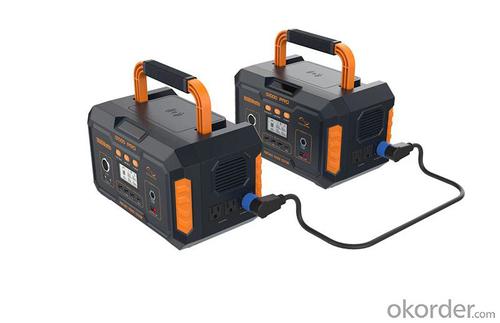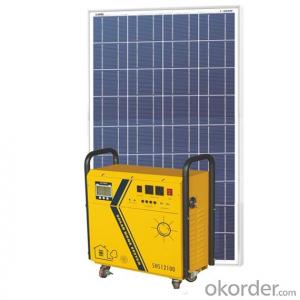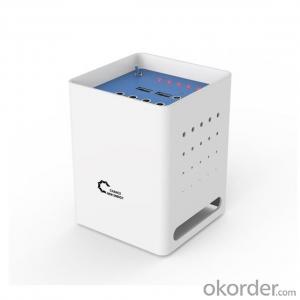oem ,odm ,500w, 1000w ,1500w lithium Portable home use solar energy system
- Loading Port:
- Shanghai
- Payment Terms:
- TT or LC
- Min Order Qty:
- 10 set
- Supply Capability:
- 5000 set/month
OKorder Service Pledge
OKorder Financial Service
You Might Also Like
Specification
This solar lighting system is ideal for places with no mains electricity such as outhouses, sheds, garages, farms, stables, as well as for camping, travel and any outdoor activities (e.g. a for a yurt).
The system is fully independent from the grid / AC power source and works purely based on sunlight energy.
During the daytime, the 12W solar panel charges a 12V battery inside the control unit, which then provides power to the 2 x 3W 12V LED lights connected via front sockets on the control unit.
In addition, there is a standard 5V USB socket for charging mobile phones and USB compatible devices (adaptors for USB-compatible mobile phones are included).
The control unit has a built-in 4Ah battery with an automatic solar charge controller to manage the charging process and prevent overcharging.
The 12W solar panel supplied with the system can fully charge this battery within about 7-8 hours of bright sunshine (longer in cloudy weather), and the battery can provide enough energy to power 2 LED lights continuously for 14 hours, or twice as long if only one LED lights are connected.
The system is very convenient to use and install: the solar panel comes with 5m cable and each LED light comes with 4m cable with an On/Off switch.
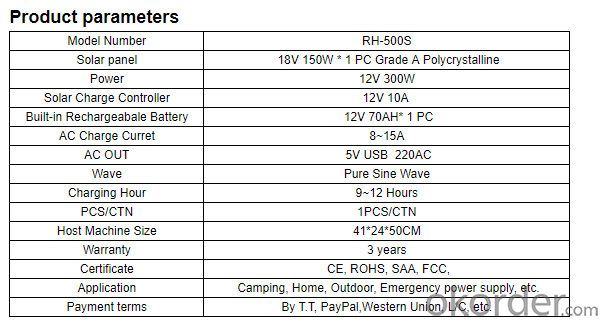
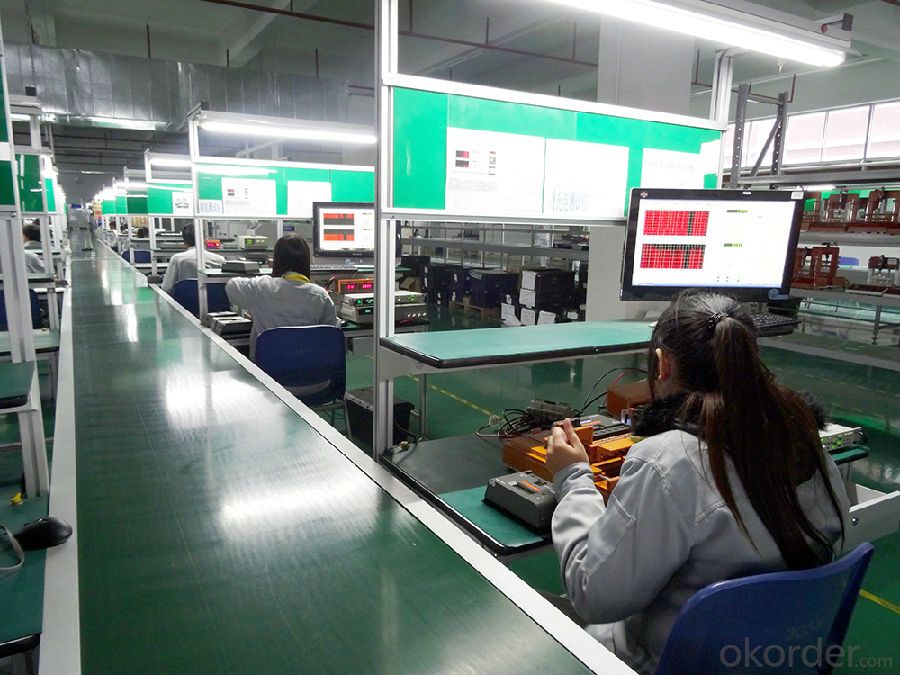
- Q: Do solar energy systems require specialized insurance?
- Yes, solar energy systems typically require specialized insurance due to the unique risks associated with their installation and operation.
- Q: Can solar panels be used to charge mobile devices?
- Yes, solar panels can be used to charge mobile devices.
- Q: How do solar energy systems impact the resale value of a home?
- Solar energy systems can have a positive impact on the resale value of a home. Studies have shown that homes equipped with solar panels tend to sell faster and at a higher price compared to homes without solar energy systems. This is primarily because solar panels offer potential buyers significant long-term savings on their energy bills. One of the key advantages of solar energy systems is that they generate electricity from a renewable source, reducing the reliance on traditional fossil fuels. This not only helps the environment but also provides cost savings in the form of reduced energy bills. Potential buyers are often attracted to homes with solar panels as they recognize the long-term financial benefits of owning a property that generates its own electricity. Additionally, many countries and states offer various incentives and tax credits for homeowners who install solar panels. These incentives can further increase the attractiveness of a home equipped with solar energy systems, as buyers may be able to take advantage of these financial incentives themselves. Moreover, solar energy systems are known to increase the energy efficiency of a home. By utilizing the sun's energy, homeowners can significantly reduce their reliance on the grid, which in turn lowers their overall energy consumption. Energy-efficient homes are highly sought after in today's market, as they not only reduce utility costs but also contribute to a greener and more sustainable future. However, it is important to mention that the impact of solar energy systems on the resale value of a home may vary depending on various factors such as the location, size, and efficiency of the system. It is advisable to consult with local real estate professionals or appraisers to get a more accurate understanding of the specific impact on the resale value in a particular area. In conclusion, solar energy systems can have a positive impact on the resale value of a home by reducing energy bills, offering long-term cost savings, and increasing the overall energy efficiency of the property. With the growing emphasis on sustainability and renewable energy, homes equipped with solar panels are becoming increasingly attractive to potential buyers, leading to faster sales and higher selling prices.
- Q: Can solar energy systems be used in powering beauty salons or spas?
- Yes, solar energy systems can definitely be used to power beauty salons or spas. Solar energy is a renewable and sustainable source of power that can help reduce the dependence on grid electricity and minimize the carbon footprint of these establishments. By installing solar panels on the roof or other suitable areas, beauty salons and spas can generate their own electricity and reduce their energy costs in the long run. Beauty salons and spas typically require a significant amount of electricity to operate hair dryers, hair straighteners, curling irons, lighting, air conditioning, and other equipment. Solar energy systems can easily meet these power demands, especially during daylight hours when the sun is shining. Excess electricity generated during the day can be stored in batteries or fed back into the grid, ensuring a continuous supply of power at all times. Moreover, solar energy systems can help improve the sustainability and environmental performance of beauty salons and spas. By switching to solar power, these establishments can significantly reduce their carbon emissions and contribute to the fight against climate change. Additionally, using solar energy can help attract environmentally conscious customers who appreciate businesses that prioritize sustainability. In summary, solar energy systems are a viable option for powering beauty salons and spas. They can provide a reliable and sustainable source of electricity, reduce energy costs, and contribute to a greener and more environmentally friendly business operation.
- Q: Can solar energy systems be used in powering warehouses or distribution centers?
- Yes, solar energy systems can definitely be used in powering warehouses or distribution centers. In fact, many businesses are increasingly adopting solar energy as a sustainable and cost-effective solution for their energy needs. Warehouses and distribution centers are typically large facilities with ample roof space, making them ideal candidates for solar panel installations. By installing solar panels on the roof or ground of these facilities, the generated solar energy can be used to power various operations within the warehouse or distribution center. This includes lighting systems, climate control, refrigeration units, conveyor belts, and other machinery or equipment. The generated energy can also be stored in batteries for later use during cloudy days or at night. Several advantages make solar energy systems a great fit for warehouses and distribution centers. Firstly, solar power helps reduce reliance on the traditional grid, leading to reduced electricity bills and long-term cost savings. Moreover, as solar energy is a renewable and clean energy source, using it reduces greenhouse gas emissions and contributes to a more sustainable business operation. In addition to the cost and environmental benefits, solar energy systems can also provide businesses with energy independence and resilience. By generating their own power, warehouses and distribution centers are less vulnerable to power outages or fluctuations in the grid, ensuring uninterrupted operations and minimizing downtime. Overall, the use of solar energy systems in powering warehouses and distribution centers presents numerous advantages, including cost savings, sustainability, energy independence, and operational resilience. As a result, more and more businesses are embracing solar energy as a reliable and efficient solution for their energy needs in these types of facilities.
- Q: Can solar energy systems be used during power outages?
- Yes, solar energy systems can be used during power outages. They can provide a reliable source of electricity as long as they are equipped with a battery storage system to store excess energy generated during the day. This stored energy can then be used to power essential appliances and devices during power outages, ensuring continuous electricity supply.
- Q: How do solar energy systems impact energy consumption patterns?
- Solar energy systems have a significant impact on energy consumption patterns by reducing reliance on traditional fossil fuel sources. These systems generate clean and renewable energy, thereby reducing greenhouse gas emissions and mitigating the harmful effects of climate change. Additionally, solar energy encourages a shift towards decentralized energy production and encourages individuals and businesses to become more mindful of their energy consumption, leading to greater energy efficiency and conservation.
- Q: Can solar energy systems be used in powering airports or transportation hubs?
- Yes, solar energy systems can be used to power airports and transportation hubs. Solar power is a renewable and sustainable energy source that can be harnessed through the installation of solar panels. These solar panels can be placed on the roofs of airport buildings, parking lots, or even on the ground surrounding the airport. Solar energy can be used to power various aspects of airports and transportation hubs. For example, solar panels can generate electricity to power lighting systems, security cameras, and other electrical equipment within the airport premises. Solar power can also be used to charge electric vehicles, such as electric buses or airport shuttles, which can help reduce carbon emissions and promote a cleaner transportation system. Furthermore, solar energy systems can provide a reliable backup power source during emergencies or power outages. This is especially crucial for airports, as they need to ensure continuous operations and maintain safety measures at all times. In recent years, several airports around the world have embraced solar energy as a way to reduce their carbon footprint and operating costs. For instance, Cochin International Airport in India became the world's first fully solar-powered airport in 2015. This airport generates more than enough electricity to meet its operational needs and even feeds excess power back into the grid. Overall, incorporating solar energy systems into airports and transportation hubs is not only environmentally friendly but also economically beneficial in the long run. It helps reduce reliance on fossil fuels, lowers energy costs, and contributes to a more sustainable and greener transportation infrastructure.
- Q: Can a solar energy system be integrated with other energy sources?
- Yes, a solar energy system can be integrated with other energy sources. This is known as a hybrid energy system. By combining solar energy with other sources such as wind, hydro, or traditional electricity grids, it is possible to ensure a stable and reliable energy supply even during periods of low solar generation or high demand. This integration allows for better energy management and can increase the overall efficiency and sustainability of the system.
- Q: What happens to excess electricity generated by a solar energy system?
- Excess electricity generated by a solar energy system is typically fed back into the grid, allowing other consumers to benefit from the surplus power. This process is known as net metering, where the excess energy is credited to the system owner's account and can be used to offset future electricity bills.
Send your message to us
oem ,odm ,500w, 1000w ,1500w lithium Portable home use solar energy system
- Loading Port:
- Shanghai
- Payment Terms:
- TT or LC
- Min Order Qty:
- 10 set
- Supply Capability:
- 5000 set/month
OKorder Service Pledge
OKorder Financial Service
Similar products
Hot products
Hot Searches
Related keywords






